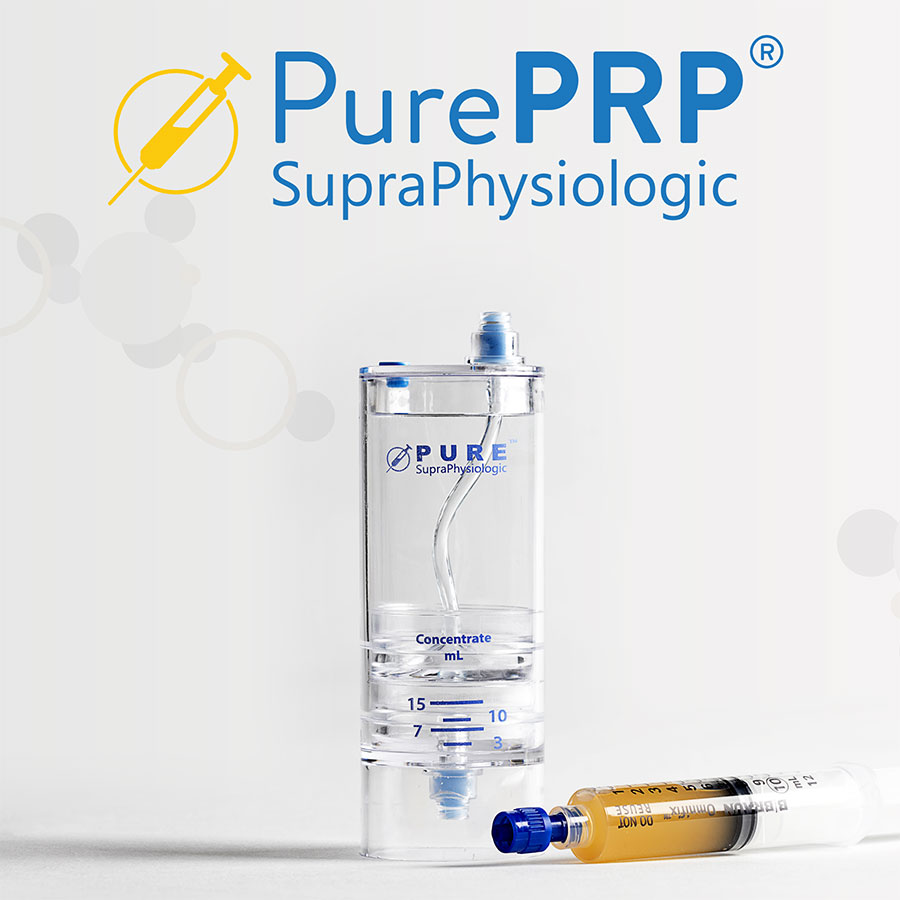Platelet Rich Plasma (PRP) therapy is a minimally invasive, non-surgical treatment that relieves pain by promoting long-lasting healing of musculoskeletal conditions using your body’s own growth factors.
The body’s natural response to an injury is to send platelets from the blood to the damaged tissues which initiates the natural healing process.
For decades, high level athletes have used PRP therapy to avoid surgery and benefit from shortened injury recovery times. By enhancing the body’s natural healing capacity, PRP therapy has been shown to lead to a more rapid, efficient and more thorough healing and stabilization of tissues, bringing them back to a healthy state.
Platelet Rich Plasma Therapy FAQs
Blood is drawn from your arm and run through a centrifuge which separates the blood into its components. Plasma, which contains the beneficial platelets, is collected and further refined. The PRP solution is then injected into the affected area (joint space, disc or soft tissue such as tendons or ligaments). Ultrasound or fluoroscopic guidance is frequently used to ensure precise delivery of PRP in a procedure that takes under half an hour.
PRP treatments are typically given in the doctor’s clinic and can take between 30 minutes to an hour, from pre-procedural prep all the way through to putting a bandaid on the injection site.
Many patients resume their activities immediately following the procedure. Some patients experience a mild flare-up of symptoms following a PRP injection. This will resolve in a day or two. Your provider will discuss specific limitations and rehab protocols with you before leaving the office.
Immediately after the procedure, it is recommended that you not soak your body in water for 24 hours (ie. baths, hot tubs) to mitigate the risk of infection at the injection site. Showering is fine. Do not take anti-inflammatory drugs (NSAIDs) For pain relief, extra-strength Tylenol is recommended. Ice is not recommended as it causes vasoconstriction. That said, heat is acceptable for pain relief.
Most patients report an increase in pain and some swelling immediately following the injection, lasting up to several days. This is normal and results from the body’s natural inflammatory response flooding the region with healing factors. Please notify your physician if this increased pain does not resolve itself within three days. At about 2 weeks post-procedure, most patients will experience some relief from pre-injection pain levels. The greatest benefit is typically reported at 4-6 weeks post-injection and can occur up to 6-9 months after.
To maximize recovery, we strongly suggest that you adhere to the guidelines recommended by your treating physician. This may include short-term non-weight bearing protocols, reduced activity, formal physical therapy, and at-home exercises.
Your treatment plan is created based on the severity and duration of the injury or degeneration. Usually, one treatment with PRP is sufficient for returning to desired activities after 6-8 weeks of rehabilitation and at-home exercises and progression. However, more severe conditions may need ‘booster’ shots after four weeks. Your provider will evaluate your situation and advise if you need repeat treatment after your first follow-up appointment.
The healing that occurs from PRP therapy is usually long-term. However, if the etiology of the injury is not addressed (such as flat feet leading to knee or hip pain), then repeated wear and tear will continue to degrade the joints and/or tendons. For this reason, a comprehensive approach that includes PRP therapy, structured physical therapy, and other adjunctive therapies are recommended.
Pre-procedural restrictions are necessary to ensure a good quality PRP with high platelet integrity. Please let your provider know what medications and supplements you are currently taking so that they may advise you appropriately.
Please adhere to the following guidelines:
- Stop NSAIDs 1-week pre-procedure (2 weeks is most optimal)
- Ideally, stop any blood thinners 3-5 days pre-procedure. Consult with your prescribing provider to ensure that this can be done safely
- Stop any anti-inflammatory supplements 1 week prior to the procedure (eg. Vitamin E, turmeric, curcumin, fish oil, ginseng, ginkgo, ginger, garlic extract, etc.)
- Arrive early to your appointment and make sure that you are well-hydrated
- Minimally invasive, non-surgical procedure
- Enhanced healing with your own natural healing factors
- Extremely low incidence of side effects
- Minimal downtime – Ability to carry on with your usual routine post injection
- Knee
- Shoulder
- Foot & Ankle
- Elbow, Hand & Wrist
- Spine / Back
- Hip
PRP is ideal for patients who have not found success in more conservative or traditional treatments, such as steroid injections, viscosupplements, physical therapy or bracing. PRP may also be an effective option for candidates that wish to attempt to delay or avoid a surgery.
Unlike cortisone or other injectable medications, PRP is a natural substance derived from your body, limiting adverse reactions. As with any injection, there is a minor risk of infection, bleeding, and damage to local structures. To limit this, your provider will cleanse the area and follow universal precautions.
PRP injections are usually well-tolerated with a local anesthetic injection. In cases where there is increased anxiety associated with pain, a mild sedative may be used.
PRP can be highly effective in substantially reducing pain in patients with even advanced arthritis. Often, patients are able to delay total knee replacement for years with PRP therapy.
The cost of a PRP treatment varies based on the procedure performed. Our office staff can assist you with payment options and answer any other questions you may have.
Although PRP in musculoskeletal applications is well supported by clinical evidence, the broader use of PRP therapy in treating pain is still considered relatively new at this time. Because of this, PRP is not typically covered by commercial insurance companies or Medicare and is provided as a cash-pay procedure. Our office staff can assist you with additional questions.

